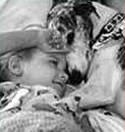

From the earliest documentation of the benefits of pet therapy, Dr. Levinson (Hooker et al., 2002) found the dog presence to be a positive effect in communication, building a rapport, and initiating therapy with the child client. Research indicates that animal companionship may be associated with lowered heart rates and blood pressure, reduced anxiety, alleviation of depression, and greater self-esteem (Martin & Farnum, 2002). Martin and Farnum suggest that animals are crucial in children social and cognitive development. Barker (1999) indicates how pets have potential benefits to the child development using the framework of Erikson stages of psychosocial development. According to these stages, pets may contribute to the development of the following:
1) a child basic sense of trust through the pet constancy, security, reliability, love and affection, and the ability to serve as a transitional object; 2) a sense of autonomy and initiative through the pet serving as an active playmate and promoting exploration of the environment, and encouraging patience and self-control; 3) a sense of industry through the pet trainability and response to the child basic commands; and 4) a sense of identity through the pet serving as a companion and confidant, and providing social and emotional support (Barker, par 4).

Furthermore, a study was done in Philadelphia that demonstrated the positive impact of pet therapy on children who had a history of consistent failure in school, behavioral problems, or serious psychiatric conditions (Golin & Walsh, 1994). Dr. Katcher, who authored this study stated thatexposure to the animals seemed not only to reduce symptoms of hyperactivity and what we call conduct disorder, but it also increased the children learning capabilities.(Golin & Walsh, p.81). Another study also demonstrated the effect of pet therapy in preschool children during a routine physical examination (Moody et al., 2002). The findings of the study showed a greater reduction in blood pressure, heart rate and behavioral distress of the children with the presence of a dog during the examination (Moody et al.). Pet therapy also has a great impact on hospitalized children, children suffering from pervasive developmental disorders, and children with chronic illnesses.